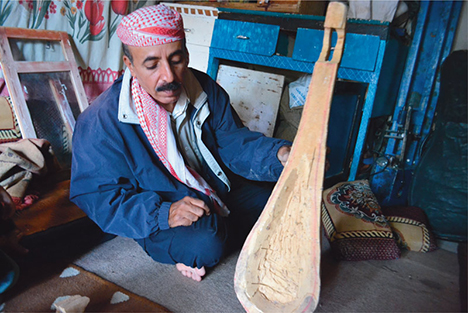
Photograph by Ali Abulohoom
The Yemeni Turbi
by Ali Abulohoom, Yemen Times, August 22, 2013
When he was 8 years old, Fuad Al-Qotari found a piece of wood lying around while playing with some neighborhood kids. He later learned that the object was actually a turbi, an instrument that had nearly disappeared from the Yemeni music scene after the 1920s.
Shortly after discovering his new find, Al-Qotari left Hashed district and moved with his family to the country’s capital, Sana’a, exposing him to more music. He began to follow many of the day’s most accomplished musicians and starting saving money for his own instrument.
His first instrument was the oud, and he was fascinated with its construction. “How [this] instrument was made interested me more than playing [it],†Al-Quotari said.
While he played some tunes of other musicians, his curiosity about the oud’s design was too strong. He put his instrument in water for hours and waited until it fell apart so that he could study each individual part.
Al-Qotari began replicating the parts of the instrument and soon began selling his own ouds. After turning 20, Al-Qotari decided he wanted to start making turbis as well. The only one he could track down was at the Musical Heritage Center. He also relied on old videos of performers such Qasim Al-Akhfash.
“Many people can make the oud, but I wanted a challenge—to bring back the turbi.â€
In the 1980s, Al-Qotari established a small studio in the Old City devoted to his turbi-making.
“I did not inherit this profession, I was not taught these skills by another person. I relied on photos of the turbi and seeing the instrument at the Musical Heritage Center,†Al-Qotari said.
Similar, but different
The turbi is a Yemeni instrument and shares many similarities to the oud. But there are also differences. The turbi is slimmer than the pear-shaped oud, which is twice as wide. The turbi has seven strings, compared to the oud’s 12. And unlike the oud, the turbi has a small mirror on the neck of the instrument. Al-Qotari explained that the mirror functioned similarly to the evil-eye symbol. It protects the musician from the envy and ill-wishes of others.
Al-Qotari is the only person in Yemen making the Yemeni instrument, likely making him the only person in the world reproducing the turbi. Few people play the turbi—demand for the instrument is low.
One turbi takes weeks to make, though it is more profitable than an oud. Al-Qotari uses different kinds of wood, including Tanb, Al Jawz and Al Ambrood wood. He prefers the Tanb because it is light and durable.
One of Al-Qotari’s ouds, known for their quality, costs $500. A turbi costs between $1,000 and $1,500.
Slow progress
Musicians have historically been considered members of a low class in Yemen consisting of barbers, butchers and others. While many of the stigmas related to those professions still linger, the 1980s were a more difficult time for a man in his 20s to announce to his family that instrument-making was his chosen path.
Al-Qotari’s choice of profession alienated him from his family. Al-Qotari is a pseudonym he chose when he started selling turbis. The name-change was an attempt to seal his profession from his family, who did not consider the profession respectable.
“I found it necessary to change my last name from Al-Qudaimi to Al-Qotari. It was a made-up name so that I wouldn’t be associated with any family and so that no one could identify me,†he said.
But Al-Qotari’s family did find out.
While attitudes towards musicians and others of that class are changing for the better, Al-Qotari still faces scorn from his family, he said. He closed his studio in the Old City and moved far across Sana’a, near the airport.
“My family’s perspective of my profession has not changed [with] the passage of time,†he said. “As blame and harassment continued, [I decided] to move so that I could work in a [more] suitable environment.â€
The trauma of being cut off from one’s family would prove too much for many people, but not for Al-Qotari
Though his family’s feelings towards his profession are less than warm and encouraging, he says that he finds encouragement knowing that he is helping to preserve Yemen’s culture and history.